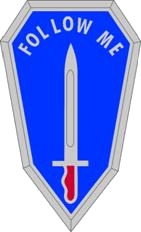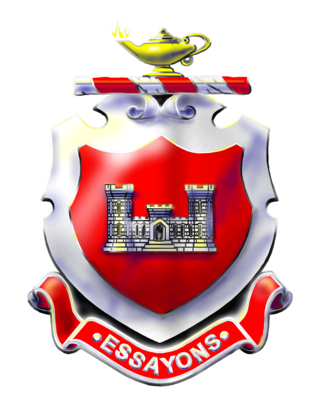
Military recruit training, commonly known as basic training or boot camp, refers to the initial instruction of new military personnel. It is a physically and psychologically intensive process, which resocializes its subjects for the unique demands of military employment.

Fort Moore is a United States Army post near Columbus, Georgia. Located on Georgia's border with Alabama, Fort Moore supports more than 120,000 active-duty military, family members, reserve component soldiers, retirees and civilian employees on a daily basis. As a power projection platform, the post can deploy combat-ready forces by air, rail, and highway for their designated mission. Fort Moore is the home of the United States Army Maneuver Center of Excellence, the United States Army Armor School, United States Army Infantry School, the Western Hemisphere Institute for Security Cooperation, elements of the 75th Ranger Regiment, the 1st Security Force Assistance Brigade, and other tenant units.

A drill instructor is a non-commissioned officer in the armed forces, fire department, or police forces with specific duties that vary by country. Foot drill, military step, and marching are typically taught by drill instructors.

The 98th Infantry Division ("Iroquois") was a unit of the United States Army in the closing months of World War I and during World War II. The unit is now one of the U.S. Army Reserve's training divisions, officially known as the 98th Training Division. Its primary mission is to conduct Initial Entry Training (IET) for new soldiers. It is one of three training divisions subordinate to the 108th Training Command (IET) and handles command and control of units throughout the eastern United States and in Puerto Rico.

Fort McClellan, originally Camp McClellan, is a decommissioned United States Army post located adjacent to the city of Anniston, Alabama. During World War II, it was one of the largest U.S. Army installations, training an estimated half-million troops. After the war it became the home of the Military Police Corps, the Chemical Corps and the Women's Army Corps. From 1975 and until it was closed in 1999, Fort McClellan was home of the Military Police Corps and the One Station Unit Training (OSUT) Military Police School. Also after World War II and until it was closed in 1999, it was home of the Chemical Corps School, which trained soldiers in chemical warfare. In 1988, Fort McClellan was used as an alternate training academy for the United States Border Patrol. Before its closure by the Base Realignment and Closure commission (BRAC), the post employed about 10,000 military personnel and about 1,500 civilians. It underwent unexploded ordnance (UXO) clean up from 2003 to 2014. Since 2010, about 3,000 acres of the post's brownfield land have been redeveloped as a mixed-use community. The portion of the post which has not been redeveloped is currently owned by the Alabama Army National Guard and is used as a training facility for units from all across the state, also housing the Alabama Army National Guard’s Officer Candidate School, for enlisted soldiers looking to earn their commission.
The United States Army Regimental System (USARS) is an organizational and classification system used by the United States Army. It was established in 1981 to replace the Combat Arms Regimental System (CARS) to provide each soldier with continuous identification with a single regiment, and to increase a soldier's probability of serving recurring assignments with his or her regiment. The USARS was intended to enhance combat effectiveness by providing the opportunity for a regimental affiliation, thus obtaining some of the benefits of the traditional regimental system.

The United States Army Infantry School is a school located at Fort Moore, Georgia that is dedicated to training infantrymen for service in the United States Army.

The reorganization plan of the United States Army was implemented from 2006 to 2016 under the direction of the Brigade Modernization Command. This effort formally began in 2006 when General Peter Schoomaker was given the support to move the Army from its Cold War divisional orientation to a full-spectrum capability with fully manned, equipped and trained brigades; this effort was completed by the end of 2016. It has been the most comprehensive reorganization since World War II and included modular combat brigades, support brigades, and command headquarters, as well as rebalancing the active and reserve components.

The United States Army Armor School is a military training school located at Fort Moore, Georgia. Its primary focus is the training of United States Army soldiers, non-commissioned officers, warrant officers, and commissioned officers. It also trains for equipment handling, including the M1 Abrams, the Bradley Fighting Vehicle, and the Stryker Mobile Gun System. The Armor School moved to Fort Benning in 2010 as part of the United States Base Realignment and Closure program.
Recruit Sustainment Program (RSP) is a program of the United States Army National Guard designed to introduce new recruits to the fundamentals of the U.S. Army before they leave to basic combat training (BCT) and advanced individual training (AIT). The motto is "Paratus Preliator".

United States Army Basic Combat Training (BCT) is the recruit training program of the United States Army, for service in the U.S. Army, U.S. Army Reserve, or the Army National Guard.
The Basic Officer Leader Course (BOLC) is a two-phased training course designed to commission officers and prepare them for service in the United States Army. Prospective officers complete Phase I as either a cadet or an officer candidate before continuing on to BOLC B as Second Lieutenants. If BOLC B is not completed within two years of commissioning, 2LTs will be administratively separated from the service unless there are extenuating circumstances. This a progressive model designed to produce US Army officers with leadership skills, small unit tactics and certain branch-specific capabilities.
Fort Leonard Wood is a U.S. Army training installation located in the Missouri Ozarks. The main gate is located on the southern boundary of The City of St. Robert. The post was created in December 1940 and named in honor of General Leonard Wood in January 1941. Originally intended to train infantry troops, in 1941 it became an engineer training post with the creation of the Engineer Replacement Training Center. During World War II Italian and German POWs were interned at the fort. In 1984, as part of the Base Realignment and Closure process, most of the U.S. Army Engineer School's operations were consolidated at Fort Leonard Wood. Before that, officer training was conducted at Fort Belvoir, Virginia.

The 3rd Chemical Brigade is a training brigade of the United States Army based at Fort Leonard Wood, Missouri, retaining for historic reasons its name.

Basic Training in the United States Army is the initial training for new military personnel typified by intense physical activity, psychological stress and the development of social cohesion. The United States Army Center for Initial Military Training (USACIMT) was created in 2009 under the U.S. Army Training and Doctrine Command to oversee training related issues.

The Infantryman Shoulder Cord is a United States military decoration worn over the right shoulder of all infantry-qualified U.S. Army soldiers. It is a fourragere in light blue, specifically PMS 5415, worn under the right shoulder and under the right epaulette of a U.S. Army infantry soldier's Class A dress blue uniform jacket or Class B shirt. The cord is composed of a series of alternating left and right half knots that are tied around a leader cord to form a "Solomon bar".

The Army Reserve Officer Training Corps (AROTC) is the United States Army component of the Reserve Officers' Training Corps. It is the largest Reserve Officer Training Corps (ROTC) program which is a group of college and university-based officer training programs for training commissioned officers for the United States Army and its reserves components: the Army Reserves and the Army National Guard. There are over 30,000 Army ROTC cadets enrolled in 274 ROTC programs at major universities throughout the United States. These schools are categorized as Military Colleges (MC), Military Junior Colleges (MJC) and Civilian Colleges (CC).

The United States Army Engineer School (USAES) is located at Fort Leonard Wood, Missouri. It was founded as a School of Engineering by General Headquarters Orders, Valley Forge on 9 June 1778. The U.S. Army Engineer School provides training that develops a wide variety of engineering skills including: combat engineer, bridging, construction, geospatial, topography, diving, and firefighting.

The United States Army's Noncommissioned Officer Candidate Course (NCOCC), originally located at Fort Benning, Georgia, was created to fill the Army's critical shortage of junior noncommissioned officers with the best qualified and best trained men available. NCO Candidates (NCOC) allowed to attend the course were selected from volunteers and many candidates were among the brightest soldiers of Basic Combat Training, Advanced Individual Training or in a subsequent assignment that demonstrated outstanding leadership potential. The program was in existence only during the U.S. war in Vietnam.














